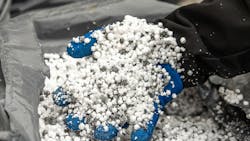Troubleshooting Sticky Solids: Solutions for Particulate Flow Problems
If you spend enough time dealing with particulate solids, you’ll encounter very sticky solids and end up spending countless hours cleaning out a plugged distributor, opening a discharge chute or banging on the vessel to get the solids to flow. There are many reasons solids clump or stick to surfaces. Let’s face it: sticky solids need special attention. But first, we must identify the source of the stickiness. The most common causes are:
- Too much solvent on the surface of the particles – While this may seem obvious, it can be hard to tell through visual or even electronic analysis when the solvent is uniformly distributed. Narrow particle size distributions are prone to this problem when the compressed particles become relaxed.
- Inadequate suspension of the solids – The particles can overheat and, in some cases, catch on fire. Although excess solvent can flash off with enough heat transfer, if the particles are resting on a surface or on other particles, they will clump or stick.
- Poor dispersion of the solids as they go into a dryer – Proper dispersion allows the solids to flash-dry before hitting other solids.
- Any design that allows solids, even those that are almost dry, to contact hot surfaces – Internal solvent content can be forced to the surface, where they may contact the surface of another dry particle.
It is widely believed that the sticky point of a material is where the critical solvent content loss goes from being a function of the heat transfer rate to mass transfer of solvent to the surface of the particles. However, it is more often a unique physical property that has to be determined in the lab. One simple way is to stir wet cake as it is being heated and observe the solvent content when the solids begin to form balls. An alternate is to throw the solids at a wall and see if they stick. The wall does not need to be hot, as the compression will squeeze solvent out of the cake.
Almost all fine solids, when wet, are sticky. Many others clump due to a variety of factors, mostly due to a lack of understanding of what makes a material sticky. In a fluid bed, the failure often stems from poor dispersion of the solids, lack of enough bed depth, low velocity through the grid, and spacing of the holes in the grid too far apart, as the following examples show:
- A centrifuge had been placed above the dryer to eliminate the need for a screw feeder. Unfortunately, if the centrifuge was over-fed, slurry dropped onto the dryer grid. The grid had tuyeres designed for a catalytic cracker instead of a dryer. There was no force applied to the solids to move the solids laterally. The tuyeres were replaced with a more robust design while retaining the tuyere spacing. The increase in velocity and horizontal gas flow tolerated the occasional centrifuge upsets, which were reduced by better instrumentation. The benefits of the new grid design didn’t stop there. The dryer product had a more uniform moisture content, partially due to the greater heat transfer to the solids. Later, thanks to another change in grid design, the plant was able to raise the capacity of the dryer.
- On a second project, the plant engineers were painfully aware of the stickiness of their product; it plugged up the centrifuge discharge on a regular basis. Also, the moisture content was higher than normally encountered in a fluid bed. The solution was to install a high-speed mill above the dryer, even though the solids already were finer than the mill could produce. It dispersed the solids over the bed without attrition of the particles. The fluid bed was split into zones, with the first very deep. This design allowed the particles to flash off the free moisture and eliminate the normally sticky surface. The deep bed required more pressure drop across the grid to ensure uniform distribution of the solids and to keep them off the grid. In addition, the higher pressure-drop requirement called for smaller grid holes that were spaced closer together to avoid hot spots.
- Another project involved a dryer suffering excessive entrainment after a recent product change presented a finer material to it. The corporate health and safety group had mandated a minimum velocity through the fluid bed of three feet/second for this product — due to frequent fires in the dryer when the velocity was below that, even though the solids could be fluidized easily at one foot/second. We replaced the grid with one that had the same pressure drop at one foot/second as the old one had at three feet/second. The lower velocity in the bed reduced the entrainment, while the higher velocity through the grid kept the solids from sticking to the grid and burning. It also improved the heat transfer and evaporation rate, enabling the dryer to maintain the same production rate despite the lower fluidization velocity.
The secret to putting particulate solids into a fluid bed successfully (which means getting them out in the desired size) is close attention to dispersion of the solids, good bed depth and careful design of the fluidization grid. Before finalizing the design of any dryer, spend time looking at the stickiness of your solids. You can also take advantage of a solids sticky nature to produce agglomerates that are strong and less dusty.
About the Author
Tom Blackwood, Solids Advice columnist
Contributing Editor
Tom Blackwood, a veteran engineer who has dealt extensively with solids over the course of his career, contributes regularly to Chemical Processing and serves as the Solid Advice columnist.

